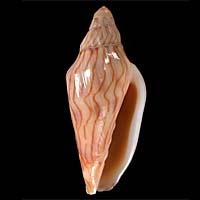|
< Previous family introduction |
|
|||||
 |
Family Volutidae Volutes
|
|||||
|
The volutes are a family of molluscs with attractive, large, glossy shells, and are one of the favourite groups with collectors. The smallest species is about 9 mm in size, but some of the baler shells reach over 500 mm. The family contains about 200 species and is distributed world wide. Of the 200 species about 70 are endemic to Australia, with concentrations of endemic species in Queensland and north-west Australia. Volutes are carnivorous, preying on small animals, including other molluscs and echinoderms. Some species live intertidally, others subtidally down to at least 500 metres. Most live in clean sand, either burrowing underneath or crawling on top. One species, Cymbiola magnifica, is trawled at night, so it is apparently buried by day and comes onto the surface at night. Volutes reproduce by direct development. The male fertilizes the female internally, and the female deposits fertilized eggs into an egg mass adhering to the substrate; crawling juveniles emerge directly from the egg, and there is no free-swimming larval stage. This leads to small distributional ranges and isolated populations which develop with their own characteristics of shell form and colour pattern. Often these populations are geographically quite close, but are separated by some barrier to migration such as a deep water channel. This effect is very noticeable with the Cymbiola pulchra species group where distinct forms have evolved on isolated reef systems of the Great Barrier Reef. In the past, such forms have been named as distinct species, but modern practice is to regard them as subspecies or forms of a variable species. About eighteen species of volutes are found in NSW, all occurring subtidally. Species which occur commonly intertidally in Queensland, such as Cymbiola pulchra, are uncommon or rare in NSW, and only found subtidally. The same is true for the common southern Australian species Amoria undulata, which occurs intertidally in Victoria but not shallower than 10 metres in NSW. Recent trawling in deeper and deeper water on the Australian continental slope yields greater bathymetric ranges than were previously recorded. For example, Ericusa papillosa is now known down to 732 metres. Distributions mainly follow two patterns. One group has a range restricted to Queensland and NSW. This includes most of the Amoria species. Within this group, a few have a short range within NSW, such as. Lyria laseroni which is known only from a 200 km range in northern NSW. The other group ranges from about the Queensland-NSW border southwards to South Australia or south-western Australia; this group includes Amoria undulata, Ericusa papillosa, E. sowerbyi and Livonia roadnightae . Family References
Coverage All the species which occur in NSW are figures here. Identification Notes Volutes have large, conspicuously patterned shells with plaits on the columella. Some species vary in shape and colouration between shallow and deep water and within their geographical range. Some species, particularly Cymbiola pulchra, vary widely in colour, pattern, size and shape from isolated population to population over relatively short distances. |